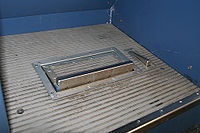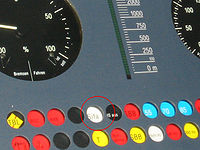
Sifa
Encyclopedia

Train
A train is a connected series of vehicles for rail transport that move along a track to transport cargo or passengers from one place to another place. The track usually consists of two rails, but might also be a monorail or maglev guideway.Propulsion for the train is provided by a separate...
intended to bring the train automatically to a stop if the driver becomes incapacitated.
Description
Sifa is German for Sicherheitsfahrschaltung or "safety driving switch", usually a pedal and/or large press button, which monitors the alertness of the driver. The driver has to repeatedly press a button after a fixed interval; if he fails to do so, the train will carry out an emergency-stop. It complements the external train safety systems: PZBPunktförmige Zugbeeinflussung
PZB or Indusi is an intermittent cab signalling system and train protection system used in Germany, Austria, Slovenia, Croatia, Romania, Israel and on one line in Canada....
, LZB
Linienzugbeeinflussung
Linienzugbeeinflussung is a cab signalling andtrain protection system used on selected German and Austrian railway linesas well as the AVE in Spain.In Germany, the system is mandatory on all lines where trains exceed speeds of...
and ETCS
European Train Control System
The European Train Control System is a signalling, control andtrain protection system designed to replace the many incompatible safety systems currently used by European railways, especially on high-speed lines.- History :...
.

Europe
Europe is, by convention, one of the world's seven continents. Comprising the westernmost peninsula of Eurasia, Europe is generally 'divided' from Asia to its east by the watershed divides of the Ural and Caucasus Mountains, the Ural River, the Caspian and Black Seas, and the waterways connecting...
the Zeit-Zeit-Sifa (time-time Sifa) is common. In this system, the engine driver holds a pedal or button down for 30 seconds and must then briefly release the pressure. Thus the system can confirm that the driver is still able to react. If the driver does not react after 30 seconds, the system warns the driver, at first optically, then for a few seconds acoustically. After a further short period of time without any reaction the train is automatically stopped. The Zeit-Weg-Sifa (time-distance Sifa) system takes account of the distance travelled, as well as time, since the last activation.
In electric trains such as those working on U- and S-Bahn
S-Bahn
S-Bahn refers to an often combined city center and suburban railway system metro in Austria, Germany, Switzerland and Denmark...
lines the Sifa has for a long time been combined with the driving switch. This is where the concept of the dead man's switch first arose. If the button was released (due to the driver falling asleep) the train was automatically stopped.
In order to test the function of the Sifa the driver must carry out a SiFa test run before the train is used in order to check that the train is automatically braked.
After serious accidents as a result of drivers falling asleep, where the pedal was still regularly activated, the Deutsche Reichsbahn in East Germany introduced a special type of Sifa (Sifa86) into service. Here the driver has to acknowledge, by pressing a button, an optical signal at a time and distance interval randomly generated by the system.
Norms
The regulations for Sifa systems in Germany are contained in German Industrial Norms (DINDin
DIN or Din or din can have several meanings:* A din is a loud noise.* Dīn, an Arabic term meaning "religion" or "way of life".* Din is one of the ten aspects of the Ein Sof in Kabbalah ....
) VDE 0119-207-5.
See also
- Dead man's switchDead man's switchA dead man's switch is a switch that is automatically operated in case the human operator becomes incapacitated, such as through death or loss of consciousness....
- Dead-man's vigilance deviceDead-man's vigilance deviceA dead-man's vigilance device is a railroad safety device that operates in the case of incapacitation of the engineer. It is a hybrid between a dead-man's switch and a vigilance control....
- Train protection system
- Watchdog timerWatchdog timerA watchdog timer is a computer hardware or software timer that triggers a system reset or other corrective action if the main program, due to some fault condition, such as a hang, neglects to regularly service the watchdog A watchdog timer (or computer operating properly (COP) timer) is a computer...
- Emergency brakeEmergency brakeOn trains, the expression emergency brake has several meanings:* The maximum brake force available to the driver/engineer from his conventional braking system, usually operated by taking the brake handle to its furthest postion, through a gate mechanism, or by pushing a separate plunger in the cab*...
- Hand brakeHand brakeIn cars, the hand brake is a latching brake usually used to keep the car stationary, and in manual transmission vehicles, as an aid to starting the vehicle from stopped when going up an incline - with one foot on the clutch , the other on the accelerator In cars, the hand brake (emergency brake,...

